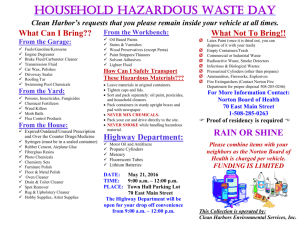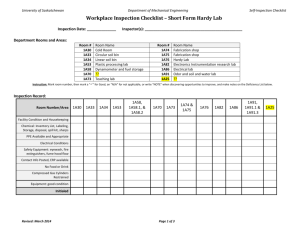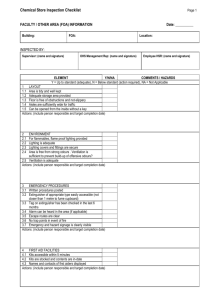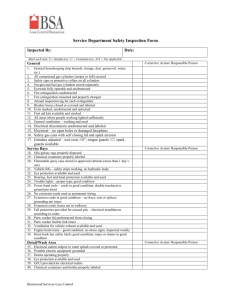Area 2 - Short Inspection
advertisement
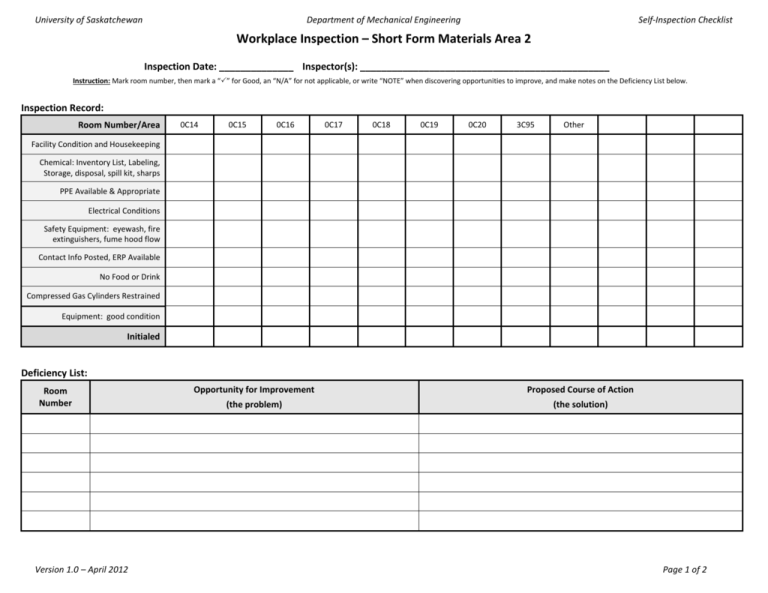
University of Saskatchewan Department of Mechanical Engineering Self-Inspection Checklist Workplace Inspection – Short Form Materials Area 2 Inspection Date: ______________ Inspector(s): _______________________________________________ Instruction: Mark room number, then mark a “” for Good, an “N/A” for not applicable, or write “NOTE” when discovering opportunities to improve, and make notes on the Deficiency List below. Inspection Record: Room Number/Area 0C14 0C15 0C16 0C17 0C18 0C19 0C20 3C95 Other Facility Condition and Housekeeping Chemical: Inventory List, Labeling, Storage, disposal, spill kit, sharps PPE Available & Appropriate Electrical Conditions Safety Equipment: eyewash, fire extinguishers, fume hood flow Contact Info Posted, ERP Available No Food or Drink Compressed Gas Cylinders Restrained Equipment: good condition Initialed Deficiency List: Room Number Version 1.0 – April 2012 Opportunity for Improvement Proposed Course of Action (the problem) (the solution) Page 1 of 2 University of Saskatchewan Department of Mechanical Engineering Self-Inspection Checklist Workplace Safety and Environmental Protection Inspection Guidelines and Reference Information: 1.0 Laboratory Housekeeping &k Practices 1.1 No Food or drink in labs (i.e. refrigerators or microwaves) 1.2 Lab and storage areas uncluttered (i.e. aisles and exits free from obstructions) 1.3 Glassware free from cracks, chips, sharp edges and other defects 1.4 Containers used to collect broken glass labeled and appropriate 1.5 Adequate lighting, ventilation and temperature control in work area 1.6 Lab bench coverings in good condition 2.0 Personal Protective Equipment (PPE) 2.1 Lab coats/uniforms stored separately from street clothes 2.2 Protective clothing available and appropriate for the type of work being conducted (i.e. gloves, goggles, safety glasses, boots, lab coats, face shields, etc.) 3.0 Hazard Communication & Storage 3.1 Chemical inventory list available and updated (includes chem. name, location & volume) 3.2 Warning signs posted on storage areas (e.g. refrigerators), equipment and laboratories consistent with hazards within 3.3 All personnel know the location and have access to up-to-date MSDS information for all controlled products in their work area (electronic or paper version) 3.4 Incompatible substances segregated 3.5 Corrosives and flammables stored below eye level 3.6 Hazardous substances used/stored in the laboratory limited to small quantities 3.7 Tops of cabinets and shelves free from stored items (i.e. 45 cm space between ceiling and items) 3.8 All hazardous substance containers labeled appropriately (i.e. WHMIS labeling requirements) 3.9 Fume hoods are not used as storage locations 3.10 Hazardous substances not stored under sinks 3.11 Flammable liquid storage cabinets closed and are properly labeled 3.12 Flammables stored on open shelves in glass or plastic containers within permissible quantities (limit ≤ 50L) 4.0 Waste Handling: Non-Hazardous, Biological, Chemical, Radiological 4.1 4.2 4.3 5.0 5.1 5.2 5.3 5.4 6.0 6.1 6.2 Hazardous wastes not allowed to accumulate in the lab; disposed of regularly Waste containers labeled according to the Hazardous Waste Disposal Manual Is secondary containment provided for chemical containers stored on the floor Compressed Gas Cylinders Gas cylinders properly secured to prevent falling (secured with a strap or chain) Cylinder caps applied when cylinders not in use or in transport All gas cylinders properly marked as to their contents Hoses, tubing and regulators in good condition Means of Egress and Emergency Emergency response and evacuation plans available (i.e. fire, power outage, spill, etc) Emergency Contact Information form posted and current 6.3 Spill response kits available for the appropriate hazards and routinely inspected 7.0 Safety Equipment 7.1 Safety showers and eyewash stations clearly labeled, checked monthly and free from obstructions 7.2 Fire extinguishers checked annually and free from obstruction 7.3 Emergency shut off valves free from obstruction 7.4 First-aid supplies and register (logbook) readily available and clearly labeled 7.5 Fume hood sash and inflow annually tested 7.6 HF first aid kit (check expiry date on calcium gluconate) 8.0 Polisher – Disk 8.1 Drive mechanism guarded – no open belts, gears or chains 8.2 Power supply cord in good condition and hard wired to machine – no cuts or exposed external wires 9.0 Electrical 9.1 Access to electrical panels not blocked or covered by materials – 1 meter in-front must be clear at all times 9.2 Cords in good condition 9.3 Extension cords not a trip hazard or used with high current devices 10.0 Work Shop House Keeping 10.1 Slip, Trip and Fall hazards removed 10.2 Racking/shelves secured to wall or bracketed – very critical if narrow and tall 10.4 Isles kept clear and exits not blocked 10.5 Cords, wires and hoses stored when not in use (coiled) 10.6 Cords secured down when exposed to foot traffic Contact WSEP Workplace Safety and Environmental Protection at 966-4700 or www.usask.ca/wsep Version 1.0 – April 2012 Page 2 of 2
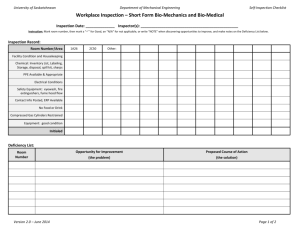
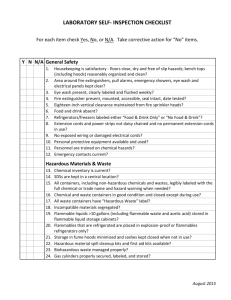
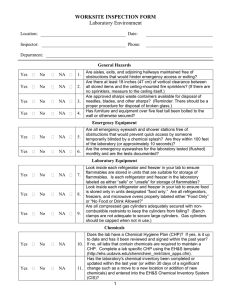
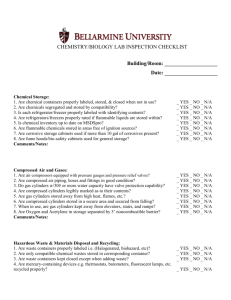
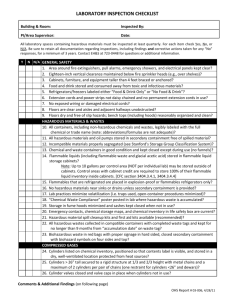
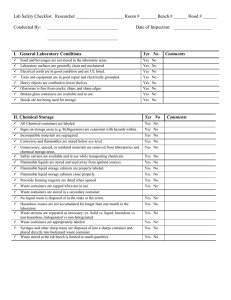
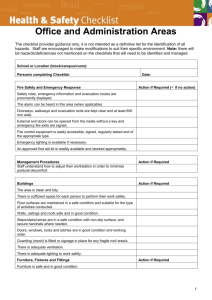
![B. ANNUAL CAMPUS EHS INSPECTION CHECKSHEET [ BIO / CHEM ] Methodist University | Office of Environmental Health and Safety](http://s2.studylib.net/store/data/011933406_1-402b18c49141c7240c4a4d3fd3fc4396-300x300.png)
